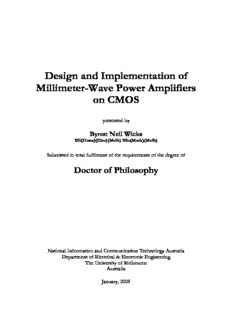
Design and Implementation of Millimeter-Wave Power Amplifiers on CMOS PDF
Preview Design and Implementation of Millimeter-Wave Power Amplifiers on CMOS
Design and Implementation of Millimeter-Wave Power Amplifiers on CMOS presented by Byron Neil Wicks BE(Hons)(Elec)(Melb) BSc(Math)(Melb) Submitted in total fulfilment of the requirements of the degree of Doctor of Philosophy National Information and Communication Technology Australia Department of Electrical & Electronic Engineering The University of Melbourne Australia January, 2009 Dedicated to my family, friends, and teachers, thank you. - iii - Abstract This thesis develops the theory and design techniques used to implement Complementary Metal–Oxide–Semiconductor (CMOS) millimetre-wave power amplifiers for use in integrated wireless transceivers allowing low cost, power efficient, high data rate and highly integrated transceivers for communication and radar applications. Although technology is constantly improving and knowledge is continually advancing the full integration of a power amplifier on die remains a challenge for millimetre wave transceivers. This is due to several causes: the reduction in supply voltage with the scaling of CMOS technology; the limited power gain of the active devices at millimetre-wave frequencies; and the high parasitic losses of the submicron CMOS process. From the theory developed in this thesis several power amplifiers have been designed, implemented and tested including a millimeter-wave automotive power amplifier, a 75 – 95 GHz wideband power amplifier and a 60-GHz Doherty power amplifier. - v - Declaration This is to certify that (i) This thesis comprises only my original work towards the PhD, (ii) Due acknowledgement has been made in the text to all other material used, (iii) This thesis is less than 100,000 words in length, exclusive of tables, maps, bibliographies and appendices. Byron Neil Wicks, January, 2009 - vii - Acknowledgement This dissertation would not have been possible without the support of a great many people throughout my education, whether explicitly mentioned here or not, and to these people I am indebted. First and foremost, I would like to thank my advisors: Professor Mareels for his invaluable advice and support over the years, for introducing me to the idea of what a research project entails and for his guidance throughout the process; Professor Skafidas and Professor Evans whose advice on technical matters was invaluable, and their guidance both on my individual project and the larger GiFi transceiver project was critical to the project’s success. To my fellow GiFi students, this work could not have been completed without your significant input and assistance. Thank you for the countless hours of help on the design, layout and testing of the transceiver, listening to my questions, humouring some of my theories and for all the general banter you provided. You have helped stop the dam breaking open many years too soon, helped me find some room upon the hill, and stopped my head exploding with dark forebodings too, so thank you, Chien M. Ta, Frank Zhang, Wave Yang, Yuan Mo, Tom Wang, Yu Feng, Jerry Liu, Gordana Felic, Praveen Nadagouda, Tim Walsh and Luan Ismahil. I’d also like to recognise a number of graduate students and fellows from outside my technical field, but who definitely added to my overall experience at the University of Melbourne. They include Sumith Choy, Elma O’Sullivan-Greene, Brian Krongold, Sam McLaughlin, Andrea Varsavsky, and Adrian Mancuso. Finally, this PhD would have not been possible without the constant love and support of my family throughout the many obstacles encountered over the decade that I have spent as a tertiary student. Their help had been essential in the completion of not only this work but - ix - all my endeavours. I would not be where I am today with out them, without their contributions and the foundation that they have provided throughout my life. Funding for this work was provided by National ICT Australia. National ICT Australia is funded by the Australian Government's Department of Communications, Information Technology, and the Arts and the Australian Research Council through Backing Australia's Ability and the ICT Research Centre of Excellence programs. - x -
Description: